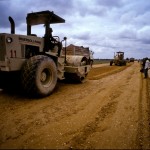SDG 12 Responsible consumption and production
SDG 12 – “Ensure sustainable consumption and production patterns” – has a monitoring framework of 11 targets and 13 indicators. Unmanaged consumption and production can contribute to depletion of natural resources.1 Sustainable consumption and production (SCP) requires a fundamental shift in the way we use services ...
Disasters

Introduction The Lower Mekong Countries (LMCs) are extremely vulnerable to disasters. Vietnam and Thailand were in the top ten countries in the world most affected by weather-related events over the period 1999-2018.48 In 2018 Cambodia, Lao PDR, Myanmar, and Vietnam all ranked in the top 50 ...
Special Economic Zones in Context

Since the establishment of the Shenzhen SEZ in China during the 1980s, Special Economic Zones (SEZs) as a development model have grown in popularity in Asia, alongside official development aid. SEZs have been promoted as being a resilient form of economic development, with the potential ...
Pandemics

COVID-19 in the Mekong The novel coronavirus has triggered a global response of extreme measures. The immediate changes are countable. As of April 15, 2020, over 2 million cases of the novel Coronavirus (COVID-19) have been counted globally, with over 100,000 confirmed deaths. Tech tools to ...
SDG 3 Good health and well-being
SDG 3 – “Ensure healthy lives and promote well-being for all at all ages” – has a monitoring framework made up of 13 targets and 26 indicators. It covers maternal (3.1) and newborn/children’s health (3.2), communicable (3.3) and non-communicable diseases (3.4), substance abuse (3.5), traffic ...
SDG 4 Quality education
SDG 4 – “Ensure inclusive and equitable quality education and promote lifelong learning opportunities for all” – is made up of a global monitoring framework of 10 targets and, starting in 2020, 12 indicators. Education is considered a fundamental human right176 and a core enabler ...
Urban administration and development

The Lower Mekong region is home to some of the world’s most dynamic cities. Bangkok, Ho Chi Minh City, Hanoi, and Yangon all have populations in excess of 5 million and are still growing. Phnom Penh and Vientiane are smaller but their growth has been ...
Rivers and lakes

Introduction Rivers and lakes are two types of surface water. In Cambodia, Laos, Myanmar, Thailand and Vietnam (or the Lower Mekong Countries), the majority of surface water is organized into large river systems that network into streams, lakes, ponds and wetlands, and flow into deltas. It ...
Disasters and emergency response

Disasters The five countries of the Lower Mekong make up one of the most disaster-prone regions in the world. Cambodia, Lao PDR, Myanmar, Thailand and Vietnam are frequently affected by natural disasters, primarily floods, tsunamis, storms and drought. Other potential risks include earthquakes, fires, pandemics, landslides, ...
SDG 9 Industry, innovation and infrastructure
SDG 9 – “Build resilient infrastructure, promote inclusive and sustainable industrialization and foster innovation” – is made up of eight targets and 12 indicators. SDG 9 addresses three aspects of sustainable development: infrastructure (9.1, 9.4, 9.A), inclusive industrial development (9.2) including a focus on small-scale ...
Regional Human Rights Mechanisms and Special Economic Zones

Introduction The Chinese government has accepted three recommendations (made by Ecuador, Peru, and Kenya) to address the human rights and environmental impacts of overseas Chinese investment and infrastructure projects. This signals a shift in the way that China has been approaching the human rights and environmental ...
SDG 2 Zero hunger
SDG 2 – “End hunger, achieve food security and improved nutrition and promote sustainable agriculture” – has a monitoring framework made up of eight targets. The framework began with 14 indicators, but it now has 13 indicators. This goal highlights the interlinkages between food security ...
Gender and infrastructure development

Infrastructure development has both positive and negative impacts on many different communities. Such development can take up large amounts of land and require many people to move. They impact various segments of communities differently, especially women. For instance, women are rarely represented in public participation ...
SDG 8 Decent work and economic growth
SDG 8 – “Promote sustained, inclusive and sustainable economic growth, full and productive employment and decent work for all” – is made up of 12 targets and 17 indicators, including two that repeat in SDG 12 (8.4.1/12.2.1 and 8.4.2/12.2.2). These targets address economic growth and ...
SDG 10 Reduce inequality
SDG 10 – “Reduce inequalities within and among countries” – is made up of 10 targets and 11 indicators. SDG 10 will be reviewed at the High-Level Political Forum in 2019, along with SDGs 4, 8, 13, and 16. SDG 17 is reviewed annually. ...
Aid and development

Official Development Aid into the five countries of the Lower Mekong Basin accounts for just 1% of the world’s total. While Thailand began paying back its ODA debt in 2000, the amount of ODA to the four other countries increased between 2004 and 2013. ...
SDG 5 Gender equality
SDG 5 – “Achieve gender equality and empower all women and girls” – has a monitoring framework of nine targets and 14 indicators. The goal encompasses discrimination (5.1), violence (5.2), harmful practices (5.3), unpaid work (5.4), leadership (5.5), and women’s and sexual health (5.6), as ...



